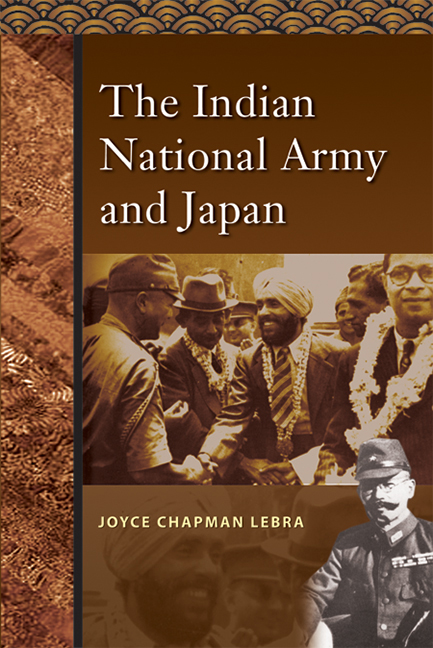Book contents
- Frontmatter
- Contents
- Illustrations and Maps
- Abstract
- Foreword
- Preface
- Acknowledgements
- Introduction
- 1 Mission to Bangkok
- 2 Malayan Jungle Meeting
- 3 Singapore Capitulates and the INA Blossoms
- 4 Tokyo Conference
- 5 Japanese Policy toward India
- 6 The Crisis of the First INA
- 7 Subhas Chandra Bose, Hitler, and Tōjō
- 8 Bose, the FIPG, and the Hikari Kikan
- 9 To India or Not?
- 10 The Rising Sun Unfurls; the Tiger Springs
- 11 A Plane Crash
- 12 A Trial in the Red Fort
- 13 Retrospect
- Notes
- Bibliographical Note
- Bibliography
- Index
- About the Author
10 - The Rising Sun Unfurls; the Tiger Springs
Published online by Cambridge University Press: 21 October 2015
- Frontmatter
- Contents
- Illustrations and Maps
- Abstract
- Foreword
- Preface
- Acknowledgements
- Introduction
- 1 Mission to Bangkok
- 2 Malayan Jungle Meeting
- 3 Singapore Capitulates and the INA Blossoms
- 4 Tokyo Conference
- 5 Japanese Policy toward India
- 6 The Crisis of the First INA
- 7 Subhas Chandra Bose, Hitler, and Tōjō
- 8 Bose, the FIPG, and the Hikari Kikan
- 9 To India or Not?
- 10 The Rising Sun Unfurls; the Tiger Springs
- 11 A Plane Crash
- 12 A Trial in the Red Fort
- 13 Retrospect
- Notes
- Bibliographical Note
- Bibliography
- Index
- About the Author
Summary
OPERATION U IS LAUNCHED
On 7 January 1944, IGHQ Army Directive no. 1776 was issued to the Southern Army “to capture strategic areas near Imphal and in north-eastern India, for the defence of Burma”. One of Mutaguchi's divisions, the 15th, was late in arriving, and the launching of the offensive was postponed until March. On 8 March all divisions were deployed according to plan. In mid-April the 31st Division occupied Kohima and the 33rd and 15th Divisions fell on the bottlenecks north and south of the Imphal basin respectively. Among the Japanese troops a mood of optimism prevailed.
THE INA IN ACTION AT LAST
On 24 January 1944, Colonel Katakura, staff officer of the Burma Area Army, met with Netaji to outline campaign strategy and the role of the INA in it. Colonel Shah Nawaz Khan was the third person at the secret meeting. When Katakura revealed the Japanese plan for a heavy bombardment of Calcutta simultaneous with the ground offensive, Netaji forcefully objected. Discussions finally yielded Bose's consent to the general plan, but not to the bombing. Bose gained his point that the INA fight in units of regimental size, not only in espionage and intelligence units attached to the Japanese Army.
Bose three days later called in Shah Nawaz and told him that as his guerrilla regiment, the Nehru Regiment, would be the first INA unit to see action, it would be closely watched. Shah Nawaz would have to be the model for the whole INA. Bose briefed Shah Nawaz on the deployment of battalions and told him detailed orders would come from 15th Army Headquarters at Maimyo. Japanese officers would be attached to each battalion for liaison and to arrange for supplies and transport. INA intelligence units of eight to ten men would also be attached to various Japanese forces for intelligence, propaganda and interrogation of POWs.
On 10 February Shah Nawaz met Mutaguchi at Maimyo for orders. Mutaguchi told Shah Nawaz his regiment was in charge of defence of the Haka-Falam sector in the Chin Hills against two British brigades (including Chins and Gurkhas) which might threaten Japanese supply lines. The object of the Shah Nawaz operation was to divert British attention from the main point of attack.
- Type
- Chapter
- Information
- The Indian National Army and Japan , pp. 174 - 193Publisher: ISEAS–Yusof Ishak InstitutePrint publication year: 2008



